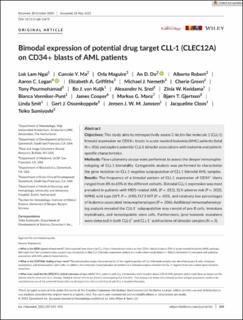Bimodal expression of potential drug target CLL-1 (CLEC12A) on CD34+ blasts of AML patients
Ngai, Lok Lam; Ma, Connie Y.; Maguire, Orla; Do, An D.; Robert, Alberto; Logan, Aaron C.; Griffiths, Elizabeth A.; Nemeth, Michael J.; Green, Cherie; Pourmohamad, Tony; van Kuijk, Bo J.; Snel, Alexander N.; Kwidama, Zinia W.; Venniker-Punt, Bianca; Cooper, James; Manz, Markus G.; Gjertsen, Bjørn Tore; Smit, Linda; Ossenkoppele, Gert J.; Janssen, Jeroen J. W. M.; Cloos, Jacqueline; Sumiyoshi, Teiko
Journal article, Peer reviewed
Published version

Åpne
Permanent lenke
https://hdl.handle.net/11250/2991210Utgivelsesdato
2021Metadata
Vis full innførselSamlinger
- Department of Clinical Science [2289]
- Registrations from Cristin [9462]
Sammendrag
Objectives
This study aims to retrospectively assess C-lectin-like molecule 1 (CLL-1) bimodal expression on CD34+ blasts in acute myeloid leukemia (AML) patients (total N = 306) and explore potential CLL-1 bimodal associations with leukemia and patient-specific characteristics.
Methods
Flow cytometry assays were performed to assess the deeper immunophenotyping of CLL-1 bimodality. Cytogenetic analysis was performed to characterize the gene mutation on CLL-1-negative subpopulation of CLL-1 bimodal AML samples.
Results
The frequency of a bimodal pattern of CLL-1 expression of CD34+ blasts ranged from 8% to 65% in the different cohorts. Bimodal CLL-1 expression was most prevalent in patients with MDS-related AML (P = .011), ELN adverse risk (P = .002), NPM1 wild type (WT, P = .049), FLT3 WT (P = .035), and relatively low percentages of leukemia-associated immunophenotypes (P = .006). Additional immunophenotyping analysis revealed the CLL-1− subpopulation may consist of pre-B cells, immature myeloblasts, and hematopoietic stem cells. Furthermore, (pre)-leukemic mutations were detected in both CLL-1+ and CLL-1− subfractions of bimodal samples (N = 3).
Conclusions
C-lectin-like molecule 1 bimodality occurs in about 25% of AML patients and the CLL-1− cell population still contains malignant cells, hence it may potentially limit the effectiveness of CLL-1-targeted therapies and warrant further investigation.
